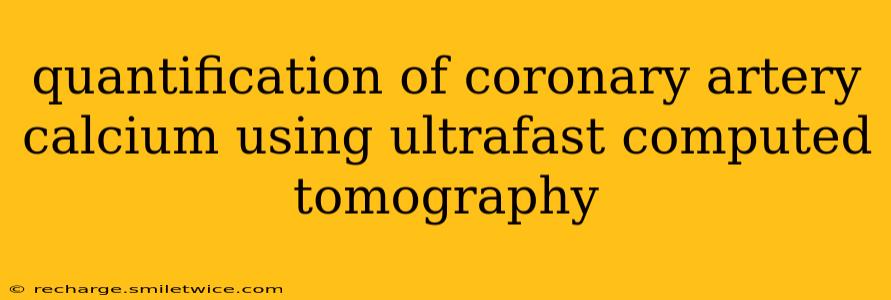Coronary artery calcium (CAC) scoring via ultrafast computed tomography (CT) is a non-invasive imaging technique offering valuable insights into a patient's cardiovascular risk. This procedure provides a precise quantification of calcium deposits within the coronary arteries, helping clinicians assess the extent of atherosclerosis and predict future cardiovascular events. Understanding the method, its implications, and limitations is crucial for both healthcare professionals and patients.
What is Coronary Artery Calcium (CAC) Scoring?
CAC scoring measures the amount of calcium buildup in the coronary arteries. Calcium deposits are a hallmark of atherosclerosis, a condition where plaque builds up inside the arteries, narrowing them and restricting blood flow to the heart. Higher CAC scores generally indicate more extensive atherosclerosis and a greater risk of future heart attacks, strokes, and other cardiovascular events.
How is CAC Quantified Using Ultrafast CT?
Ultrafast CT scanners, also known as multi-slice CT scanners, acquire images incredibly quickly, allowing for a detailed assessment of the coronary arteries in a relatively short scan time. During the procedure, the patient lies on a table that slides through the CT scanner. Contrast dye isn't typically needed for CAC scoring, minimizing the risk of adverse reactions. The scanner produces a series of cross-sectional images of the heart and coronary arteries. Specialized software then analyzes these images, quantifying the amount of calcium present in Agatston units. The Agatston score is the standard unit for CAC quantification. A score of zero indicates no detectable calcium, while higher scores represent increasing amounts of calcium.
What is the Agatston Score?
The Agatston score is a numerical representation of the total calcium burden in the coronary arteries. It's calculated by considering the area and density of calcium deposits in each coronary artery segment. A higher Agatston score reflects a greater amount of calcium and, consequently, a higher cardiovascular risk.
What are the Benefits of CAC Scoring with Ultrafast CT?
- Non-invasive: Unlike invasive procedures like coronary angiography, CAC scoring is non-invasive, meaning it doesn't require any incisions or catheters. This makes it a safer and more comfortable option for patients.
- Accurate and reproducible: Ultrafast CT provides high-resolution images, resulting in accurate and reproducible CAC scores.
- Early detection: CAC scoring can detect early signs of atherosclerosis, even before symptoms appear. This allows for early intervention and lifestyle modifications to reduce cardiovascular risk.
- Risk stratification: CAC scores help clinicians better stratify cardiovascular risk, allowing them to tailor treatment strategies to individual patients.
- Improved risk prediction: CAC scores are a powerful independent predictor of future cardiovascular events. This information can be crucial in making informed decisions about preventative therapies and lifestyle changes.
What are the Limitations of CAC Scoring with Ultrafast CT?
- Radiation exposure: While the radiation dose in modern CT scanners is relatively low, there is still some exposure. The benefits of the scan must outweigh the risks, particularly in younger individuals.
- Cost: CAC scoring can be expensive, making it potentially inaccessible for some patients.
- Not a direct measure of stenosis: CAC scoring assesses calcium deposits, not the degree of coronary artery narrowing (stenosis). Significant stenosis may occur with minimal calcium, and vice versa.
- False negative results: In some cases, significant atherosclerosis may be present without detectable calcium.
- False positive results: A high CAC score indicates increased risk, but doesn't necessarily mean a patient will have a cardiovascular event.
What is the Clinical Significance of CAC Scoring?
The clinical significance of CAC scoring lies in its ability to identify individuals at increased risk of cardiovascular events. This information can be used to guide treatment decisions, including lifestyle modifications (diet, exercise, smoking cessation), medication prescriptions (statins, blood pressure medications), and even the consideration of more invasive procedures if necessary.
How is CAC Scoring Interpreted?
The interpretation of CAC scores typically involves considering the score in conjunction with other risk factors, such as age, gender, smoking history, blood pressure, cholesterol levels, and family history of cardiovascular disease. Clinicians use risk calculators that incorporate CAC scores and other risk factors to provide a comprehensive assessment of cardiovascular risk. Different scoring systems and risk calculators may be used, leading to varying interpretations.
Who Should Undergo CAC Scoring?
The decision to perform CAC scoring is made on a case-by-case basis, considering individual risk factors and clinical judgment. Individuals with intermediate risk of cardiovascular disease may benefit from CAC scoring to refine risk stratification. However, it's not routinely recommended for everyone.
Does CAC Scoring replace other cardiovascular risk assessments?
CAC scoring is a valuable addition to traditional cardiovascular risk assessment methods, but it does not replace them. It provides additional information that, when combined with other risk factors and clinical judgment, helps clinicians make more informed decisions about patient care.
This comprehensive analysis of CAC scoring provides a thorough overview of this important cardiovascular risk assessment tool. Remember to consult with your healthcare provider to discuss whether CAC scoring is appropriate for you.
